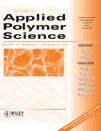Electrospun nano-scaled glass fiber reinforcement of bis-GMA/TEGDMA dental composites
Abstract
The objective of this study was to investigate the electrospun nano-scaled glass fiber reinforcement of 2,2′-bis[4-(methacryloxypropoxy)-phenyl]-propane/triethylene glycol dimethacrylate (Bis-GMA/TEGDMA) dental composites. The hypothesis was that incorporation of the surface-silanized electrospun nano-scaled glass fibers into Bis-GMA/TEGDMA dental composites would result in substantial improvement on mechanical properties. To test the hypothesis, photo-cured Bis-GMA/TEGDMA dental composites filled with various mass fractions of surface-silanized electrospun nano-scaled glass fibers were systematically fabricated; and their mechanical properties were then evaluated. The results indicated that small mass fraction substitutions (1, 2.5, 5, and 7.5%) of conventional dental filler with the surface-silanized electrospun nano-scaled glass fibers, significantly improved the flexural strength, elastic modulus, and work of fracture values of 70% (mass fraction) filled composites, by as much as 44%, 29%, and 66%, respectively. The mechanical properties of the composites could be further improved by optimizing the chemical compositions and the surface treatment methods of the fibers. We envision that the electrospun nano-scaled glass fibers could be utilized to develop the next generation dental composites, which would be particularly useful for large posterior restorations. © 2008 Wiley Periodicals, Inc. J Appl Polym Sci, 2008




